
19 minute read
Military Dogs Trained for Duty
from FF March 2021
by Forsyth Mags
BY LISA S.T. DOSS
What does it take to fulfill the high expectational standards of the United States military war dog program? Only specific breeds possess the intelligence and drive to engage in brave acts directed by their handler. Eighty-fivepercent of all military working dogs, MWD, come from countries that breed worldfamous canine lines. Before newborns open their eyes, puppies spend the first ten weeks with “Puppy Development Specialists” before departing for certified foster families. By month seven, German shepherds, Belgian Malinois, and retrievers say goodbye to puppyhood and begin training.
Advertisement
FACT: A dog has an olfactory sense 40 times stronger than a human. The Labrador, golden, and Chesapeake Bay retrievers make ideal canines for the task of detecting mines and bombs!
SELECTED FOR DOG SCHOOL
Puppies are stubborn animals that often have bad days. They respond to feelings of stress and sometimes resort to the unforgivable act of biting a human. Fiftypercent of all puppies cross the fine line between aggression and excitability. Some puppies that fail the program return to live with foster families or join new homes, while others enter an alternative training program with new handlers. Earning the coveted title of MWD leads to an extensive eight-month program with the goal that certifies canines as mission ready.
FACT: Where do you choose to work? Is it a location that’s quiet and without distraction? In training, canines need exposure to a variety of environments to follow orders. Imagine trying to concentrate in a bustling city or room without walls! Once dogs become proficient in basic commands, such as “Sit!” “Stay!” “Down!” and “Heel!” the next step is to follow orders, regardless of the location or circumstances.
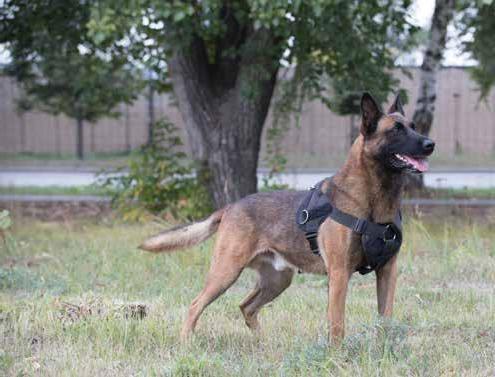
THE OBEDIENCE COURSE
The only way the mind and body can navigate small puzzles and challenges is to engage in physical and mental acuity tests. The military working dog is no exception. At Fort Belvoir, Virginia, a specialized course allows dog teams and their handlers to engage in obedience, search, and controlled aggressive training eight hours weekly. Activities may focus on one valued command, “Stay!” Over time, K9s learn specific skills, such as guarding entry control points, searching for explosives and drugs, or subduing enemy combatants.
FACT: The four-legged friend acquiesces to the family’s behavior and actions. He or she understands time and schedule from a morning feeding and walk to post-dinner cuddles in front of the television. Alphas are protectors who interpret actions and movements through body language. It could be a head tilt, a raised foreleg, or the appearance of impatience, frustration, and anger. In exercises where K9s must track and locate a fleeing subject, perhaps on the street or through wooded areas, handlers must give orders through single- or double-syllable words, assess performances, and revisit techniques to ensure strategies are near perfect!
CERTIFICATION PROCESS
Partnerships require time, trust, and play to form a deep connection. To fulfill certification requirements and achieve a partnership, the kennel master assembles real-life detection training scenarios. Across one week, teams conduct search operations from intricate, small rooms to large warehouses. In real-world exercises, teams must follow the protocol of search tactics and procedures to rescue an individual or find narcotics. FACT: Every military working dog is a noncommissioned officer, NCO, and provided with one rank higher than his handler to ensure that any mistreatment of the K9 is classified as an assault of a higherranking officer.
ADOPTING A MILITARY DOG
According to the United States Department of Defense, 2,700 working dogs are serving active-duty assignments. Ninety percent all war-dogs remain with their handlers, while 10% go to police departments or are adopted by the military or civilians. One organization, the Warrior Dog Foundation, ensures K9s have a sanctuary to live out their days of retirement with a forever family! Retirement usually occurs by years 10 to 12 due to physical or mental injury, age, or a handler’s retirement. Since 2013, the WDF has rehabilitated and re-homed over 170 K9s.
FACT: Not all agencies request retired military dogs go to a trained handler; most times, a K9 requires a happy, loving home!
At Pigtails & Crewcuts, Haircuts Are Just the Beginning!

BY TARYN JEREZ

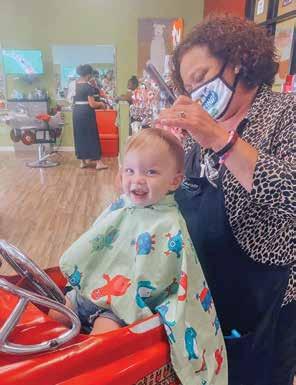
Whether a child is celebrating the milestone of their very first haircut or headed for a touch-up before school picture day, Pigtails & Crewcuts is there to provide both a haircut and a happy memory for parents and children alike.
Owner and Operator Angel Putnam first celebrated the opening of her Greensboro location of Pigtails & Crewcuts in 2017, and added her second location of the franchise in Winston-Salem in 2018. Since starting her familyowned business, she has found an abundance of joy in having her own three children grow up inside her salons, while creating a community that truly extends beyond each location’s four walls. Often, parents put “taking their child for a haircut” right up there on the list with having a toddler try on shoes or getting a kid to sit still for a dentist visit— clearly not the most enjoyable of experiences for many. Filled with bright decor, a waiting train table, and custom chairs designed like fire trucks, police cars, and even airplanes, Pigtails & Crewcuts sees first-hand how children react differently to their salon experience from the moment they step inside. Anxiety is quickly replaced with anticipation when little ones get to ride and play in their special new seat. Older kids even have the opportunity to play Xbox while their stylist snips away! Once their cut is complete and they are looking their best, each child gets to choose a special treat like a lollipop or animal cookie to take with them to enjoy, along with a small toy treasure. When asked what makes her team so special, Angel declared, “They are a group of superheroes!” What better way to describe the welcoming faces behind a children’s salon? “Truly, they are everyday heroes that bring a smile to so many families.” “We welcome the wiggles, giggles, and even tears and the fears. Each of our stylists has the love, the compassion, and the understanding to work with children of all ages, while still having the skills to give mom or dad a great haircut as well,” she noted. From cutting and styling to recommending the right hair-care products, the team of stylists genuinely love their jobs and work hard to make sure that even the littlest of their customers can see how important they really are to them. There are special memories that come out of the salon’s normal everyday moments that feel like the mission of Pigtails & Crewcuts is really being lived out. Mrs. Hicksman, a very special grandmother, recently shared her experience taking her grandson, who has autism, ADHD and other sensory issues, for a haircut, and which previously had been a very large undertaking. After calling ahead with her concerns, Angel had her stylist Mrs. Toya open early so they could be the first and only customers. After making changes to eliminate some of the sensory-related triggers, such as turning off the music, dimming the lights, and even using their quietest trimmers, Mrs. Hicksman’s grandson received his haircut and for the first time, she verified, was able to leave with “happy tears and a great cut!” It’s a wonderful reminder that even something as simple as a haircut can make someone feel safe and loved.



In an effort to continue to help their customers, both new and returning, feel comfortable and safe during COVID-19, all services are currently by appointment only. The team has also separated and distanced all of their stylists’ stations six feet apart and added designated blue family squares to keep all customer families socially distanced. Additionally, Angel Putnam shared that they recently invested and installed the iWave in both salon locations, a one-of-a-kind, in-duct air filtration system to help combat Covid. “We felt that though this was a costly step, it was a necessary one to keep our families as safe as ever. The system helps combat Covid-19 based on viral titrations. It was determined that at 10 minutes, 84.2% of the virus was inactivated. At 15 minutes, 92.6% of the virus was inactivated, and at 30 minutes, 99.4% of the virus was inactivated,” she explained. As the Spring season approaches, it’s the perfect time to get those warmer weather haircuts, and the teams at Pigtails & Crewcuts in Winston-Salem and Greensboro are ready to welcome you and your family. Whether it’s their first cut or their fiftieth, your child will experience something surely special! If you are interested in learning more about the services at Pigtails & Crewcuts, or would like to book your child’s appointment, you can do so online at www.pigtailsandcrewcuts.com/ greensboro and at www.pigtailsandcrewcuts.com/ winstonsalem.
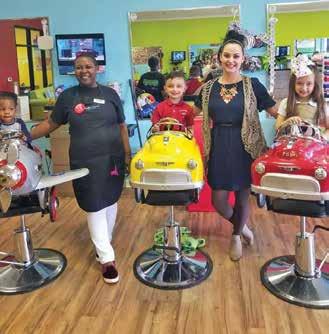
Pigtails & Crewcuts

Book your appointment with us today!
pigtailsandcrewcuts.com/winstonsalem pigtailsandcrewcuts.com/greensboro
Happy New Year, neighbors.
State Farm I wish all my neighbors a healthy, happy and safe New Year. Here’s to this year bringing you nothing Will Wilkins, Agent 6580 Shallowford Road Lewisville, NC 27023 Bus: 336-945-6996 will.wilkins.huxx@statefarm.com but the best. Like a good neighbor, State Farm is there.®
Creating a
Butterfly Garden

BY JAMIE LOBER
Many families have backyard birdfeeders and enjoy watching the beautiful visitors that come to their property. Small but alluring, butterflies have gained a lot of attention over the past few years. The North Carolina Cooperative Extension has reported that our state is home to more than 175 species of butterflies, making it a perfect spot to create a garden and see what happens. They say that a successful butterfly garden will need to provide host plants for the larvae, as well as nectar plants or other appropriate food sources for the adults.
Know Your Population
The North Carolina Government has documented some common types of butterflies found in our state. The state General Assembly even went as far as to designate the Eastern tiger swallowtail as the official state butterfly in 2012. You want to be on the lookout for the following: Pipevine swallowtail Cabbage white Cloudless Sulphur Spicebush swallowtail Zebra swallowtail Clouded Sulphur Eastern-tailed blue Red admiral American lady American snout Pearl crescent Common buckeye Question mark Pearly-eye Viceroy Monarch It can help to look up photos of these butterflies so you can recognize them when they make their way into your backyard. It will take commitment, time, and dedication, for your area to blossom.
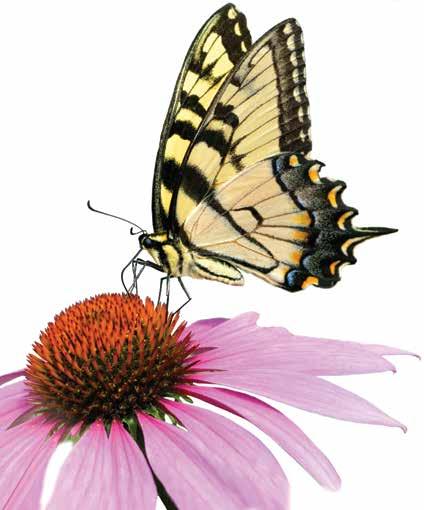
Make a Plan
Consider what will be the best means of attracting butterflies.
You have many options: • Native plants to the region also require the least maintenance and watering, since they have adapted to the area; • Nectar plants; • Flowers with different sizes and depths, as some butterflies like small flowers while others like large; • Remember to put your garden in the sun, as most butterflies are only active when it is sunny.
Treat the Home with Care
Plan ahead to make sure you can accommodate the butterflies’ needs that will soon be visiting you. Making a habitat can be a fun family project. The North Carolina Cooperative Extension has some suggestions, such as: • Leave brush piles or old foliage, so butterflies have shelter, especially from the wind; • Have a puddle of mud or a sandy area for male butterflies to hang out; • Have some small pebbles and large flat rocks for butterflies to spend time on while getting some sunshine; • Fruit peels and rotten fruit are necessary; • Minimize use of pesticides as you do not want to unintentionally kill the precious butterflies; • Try not to release purchased butterflies even for special occasions, as they can spread disease to the native butterfly population.
Butterflies are known to bond with humans and crave the friendship. In Japan, the butterfly symbolizes transformation, prosperity, good luck, and good health. Some cultures say that seeing a monarch butterfly means that you are on the right path to reaching your goals. Spiritually, many people view the butterfly for its joy and positivity. Often it can represent a life challenge, where someone comes out as a better person. You want to educate yourself about butterflies as you observe what is happening in your garden. There are so many facts that make butterflies unique, such as: • They cannot fly if they are cold; • A newly emerged butterfly cannot fly; • Butterflies taste with their feet;
• They see ultraviolet colors that are invisible to the human eye; • Butterflies have four wings, not two, as most people think; • There is evidence that some butterflies demonstrate intelligence and reasoning skills; • Rain can be a threat to butterflies;
• Butterflies eyes are called compound lenses because they can see many things in many different directions at the same time;
• Adult butterflies tend to like red, yellow, orange, pink, and purple; • Butterflies actually range from 1/8 inch to 12 inches in size.
Get Acquainted and Learn by Example
Look around at some professional setups. It can be fun to visit local butterfly gardens, or even check out what a friend or neighbor has done in their backyard. You will also notice certain flowering plants that butterflies like best. Sometimes it can come down to trial and error. You may try a plant that is not successful, and that is okay. The next plant you add might be a better fit for your habitat. Container plants, which are basically hanging baskets or window boxes, can be a great idea as well. Do not forget that you will want your garden to be in a place that you can easily observe from your window or deck, so you can take pictures of your guests and welcome them. Every family is different. You may have a stable and successful butterfly garden in a month, or it may take a year. You want to remain persistent and know that the benefits of having this special amenity in your backyard are well worth the work.
What If?
Presents Disaster Proofing Your Home
BY LISA S.T. DOSS
Embedded in our minds is the worrisome mantra, “what if” that spans topics from safety and financial security to the health of loved ones, pets and self. Pondering “What can I do?” leads to a proactive decision to invest time in the ultimate insurance policy – valuable life skills comprising security, shelter, food, water and medical care! In any emergency from extreme weather to a personal disaster, you have the power to take charge of your fate by making plans and taking action!
When we consider basic home safety for high winds, fires, freezing temperatures, hail, flooding, and earthquakes, do you wonder if you are well prepared? In the great state of North Carolina, few earthquakes arrive in the Piedmont Triad; however, the ripple effect caused when they do can lead to fires. Once homeowners begin to prepare for one natural or manmade disaster, it leads to further protection when facing most other scenarios.
Declutter
In most households with young children to preteens, piles of towels or belongings lie on staircases, while toys occupy living room floors. In situations of darkness or the need to move and act fast, it’s difficult to maneuver through a house with clutter. Make it a priority for family member to organize their belongings and clean up personal items.
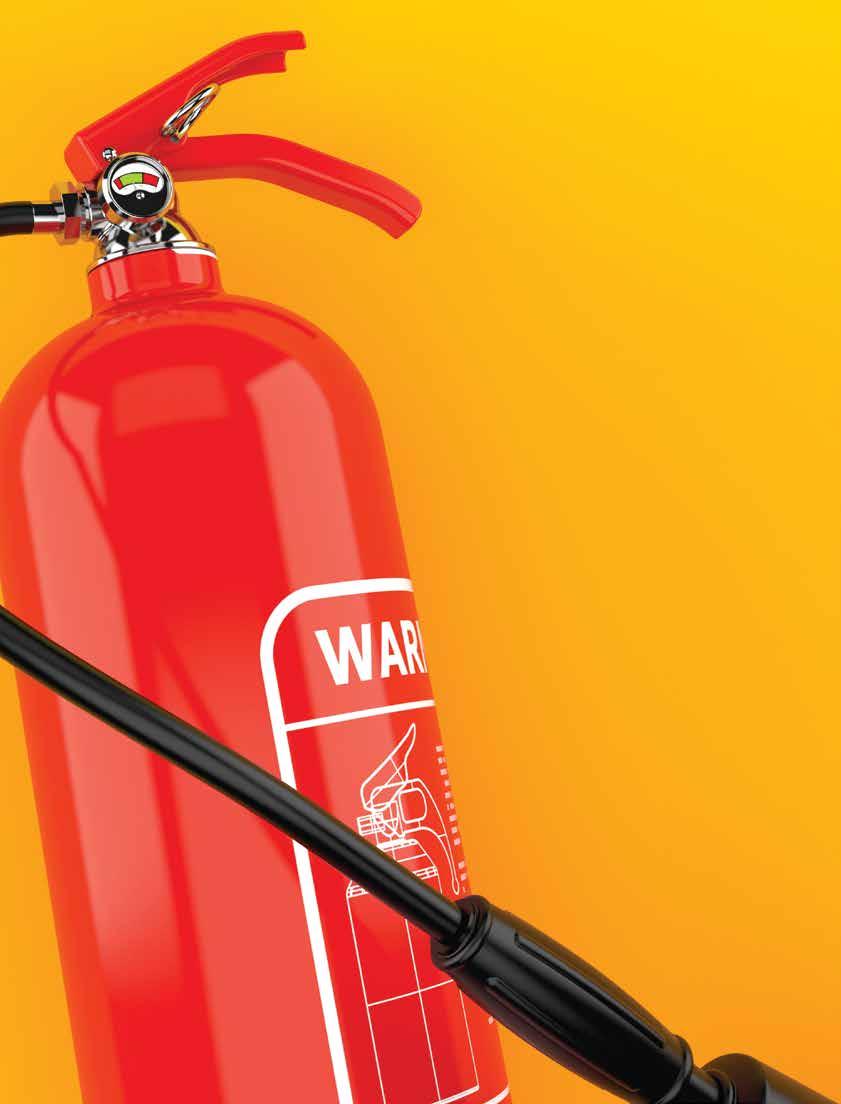
Be Window Smart
While exterior doors with large panels of glass are an attractive feature, find out their level of breakability. Decorative glass films are available as a shatterproof overlay for extra protection! Despite the two-person effort peeling film and applying, flattening, and trimming, the result is well worth the time and minimal expense!
TIP: Storm shutters are an additional layer of protection for your windows, and are made with 5/8-inch plywood or thick plastic shields.
TIP: Seal all windows and doors with a waterproof sealant.
The Ideal Roof
An impact-resistant roof is the best protection against natural forces, which can dent and tear roof coverings. Class three and four ratings are available in slate, metal, and tile products. Check with your insurer—available discounts may lower your premium.
Emergency Equipment Checks
Take a walk to the location of your shut-off valves inside and outside your home. During moments of emergency, you’ll occasionally need to stop the flow of water to appliances, fixtures, and faucets. Additionally, acquaint yourself with electric and gas valves.
Other equipment to assess:
Change the batteries of smoke detectors annually, testing the unit afterwards. Don’t forget to mark your calendar!
• Have at least one fire extinguisher in the home, preferably in the kitchen!
• Give family members a flashlight and batteries to ensure they have enough light to maneuver to a safe room.
• Have children practice walking down escape ladders and openly discuss the home escape plan in case of a fire. • Charge solar-based power banks to always have a source for cell phones, flashlights, or other items.
• Keep a solarized mini-radio, which serves multiple purposes.
TIP: Inexpensive tools are available to remove dust and lint from refrigerator coils and your dryer vent to improve your power bill and save you from a potential fire. TIP: Proper care and maintenance of your chimneys, woodstoves, and fireplaces will prevent unnecessary fires and carbon monoxide poisoning; therefore, hire a professional, certified chimney sweep company annually.
Outdoor Awareness
Are lawn furniture and decorations made out of fire-resistant materials? Deter the threat of fire by replacing bark mulch with gravel, bark, or concrete features! Being aware of potential threats and making smart purchases will ensure your family remains safe!
TIP: How far can you extend your garden hose?
Could it reach around your home? Consider investing in light-weight, non-kink options.
TIP: Determine if emergency vehicles can find your address. Are numbers large and clear on mailboxes and porch posts?
Keep asking the important questions!


THE Fancy

Fork




BY LAUREN SEPHTON



Welcome to The Fancy Fork! Your hub for seasonal produce insight and farm-style recipes that are made to satisfy.


As the days are becoming warmer, it’s time to transition to some lighter meals that are still satiating, nutrient-dense, and delicious. From the crunch of celery to the mild sweetness of grapes, the classic and comforting tastes of chicken salad are the perfect complement to ripe avocados. While avocados are available in most grocery stores year round, they are most flavorful from January to March. During this time, the avocados have developed a higher oil content, which results in that buttery flavor and smooth texture that we’ve all grown to love.


Avocados are a rather intriguing fruit that is incredibly nutritious. Unlike most fruits that are high in carbohydrates, avocados are high in healthy fats that are essential to giving your body energy and supporting cell growth. Did you know that avocados contain more potassium than bananas? Avocados can help lower cholesterol and Triglyceride levels, in addition to being loaded with fiber.



Chicken Salad Stuffed Avocados
Servings: 6
INGREDIENTS: 2-3 ripe avocados 3 cups boneless & skinless chicken breasts, cooked and shredded (about 1¼ pounds) 1-2 cups seedless red grapes, quartered 3 celery stalks, finely diced 2 spring onions, thinly sliced 1 cup plain nonfat Greek yogurt 2 Tbsp. fresh parsley or cilantro, chopped 2 tsp. honey 1 tsp. kosher salt Three-fourths tsp. black pepper ½ cup almonds or walnuts, toasted and finely chopped (optional) INSTRUCTIONS: 1. In a large bowl, mix together the shredded chicken, grapes, celery, spring onions, chopped herbs, and toasted nuts (optional). 2. In a separate bowl, whisk together the yogurt, honey, salt, and black pepper. Pour the mixture onto the chicken, then toss until well combined.
If time allows, refrigerate for 30 minutes to overnight for best flavors. 3. Slice the ripe avocados in half and remove the pits. Stuff each avocado half with a generous amount of chicken salad (each serving size is 1 cup chicken salad). 4. Leftover chicken salad will last in the refrigerator for 3-4 days.
Now, it’s time to grab your fork and enjoy the early beginnings of Spring season delights!




Names Casey Raymer Director of Annual Giving
Kaleideum has named Casey Raymer as Director of Annual Giving. Raymer comes to Kaleideum with more than 20 years of working in Winston-Salem nonprofits, most recently with ABC of NC, a local autism services provider.
Raymer, a graduate of the University of North Carolina at Chapel Hill, has been actively involved in the Winston-Salem community since her arrival in 1999. She is a graduate of HandsOn Northwest North Carolina’s Women’s Emerging Leaders Program and Leadership Winston-Salem’s Flagship Program, a past-member of the Junior League of Winston-Salem, and a committed participant on community boards and committees.
“We are thrilled that Casey has joined our team at Kaleideum. Her deep roots in the community, vast fundraising experience, and perspective on access and inclusion make her a perfect fit,” says Elizabeth Dampier, Kaleideum Executive Director. “I know that her enthusiasm for her work and boundless creativity will be invaluable to the organization.”
About Kaleideum
Kaleideum was formed by the merger of The Children’s Museum of Winston-Salem and SciWorks in July 2016. Kaleideum Downtown (formerly The Children’s Museum) was founded by the Junior League of WinstonSalem and opened its doors in 2004. Kaleideum North (formerly SciWorks), also founded by the Junior League of Winston-Salem, opened its doors as the Nature Science Center in 1964. The two museums merged into a single organization with a new mission — “Inspiring wonder, curiosity, and lifelong learning in our children and community through interactive play and discovery.”










